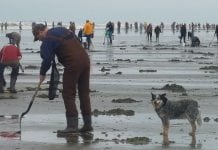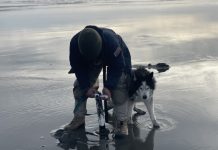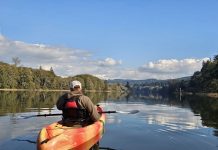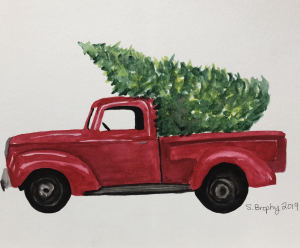This calendar is the place to find fun events happening throughout Grays Harbor County including Aberdeen, Hoquiam, Westport, Ocean Shores, Elma, Montesano and beyond.
Have an event that isn’t listed? Please email events@GraysHarborTalk.com with the following information:
- Name of Event
- Date, time and location (name of business if applicable and complete address)
- Organizer(s) name
- Cost
- URL to purchase tickets
- Website URL
- SHORT description of event
- Photo
Our editors will review and post within a few business days.

The 2019 Annual Garden Tour – Gardens, Sea, and Art – will be held Saturday, July 20, 2019, from 10:00 am to 4:00 pm featuring gardens in Ocean Shores.
It is provided by the WSU Master Gardeners of Grays Harbor and Pacific Counties.
Tickets are $12 and more information is available by calling 360-482-2934 or visiting our web site at: https://extension.wsu.edu/graysharbor/event/2019-garden-tour/

Consumers lose billions of dollars each year to fraud. People over age 50 are especially vulnerable and account for over half of all victims, according to a study by AARP. Please join us for a presentation with Elena G. Huizar, Outreach Services Supervisor in the Consumer Protection Division of Washington to learn about the more common scams targeting seniors and how to avoid them.
Job seekers will have the opportunity to connect with employers, training programs and other programs at this event.
Connect with employers from:
• Starbucks
• Overstock.com
• Sierra Pacific Industries
• Temp-to-Hire Agencies
• Other local business
Job opportunities include:
Call center representative, laborer, millwright, barista, cashier, etc…
Resources and assistance from:
• DSHS Mobile Unit
• Elma Timberland Library
• Veteran Services
• Other service providers
Register at WorkSourceWA.com
The event is a partnership with WorkSource.
Join others in a conversation about the book “In the Kingdom of Ice” by Hampton Sides. Everyone is welcome to join any or all discussions.
Come help us celebrate the library’s 25 years of community service by having cake and refreshment provided by the Friends of the Elma Library.
Chair yoga is a gentle form of yoga that is practiced sitting on a chair, or standing using a chair for support. Come relax as Stephanie leads us through calming stretches and balance. Please wear comfy clothes bring a towel and a yoga mat if you have one.
Razor clam diggers may be able to return to Long Beach for a three-day opening beginning Sept. 27, pending favorable marine toxin results later this month.
The upcoming dig is proposed for the following dates and morning low tides:
- Sept. 27, Friday, 5:52 a.m. -0.9, Long Beach only
- Sept. 28, Saturday, 6:36 a.m. -0.8, Long Beach only
- Sept. 29, Sunday, 7:19 am -0.6, Long Beach only
Final approval of the scheduled opening will depend on whether results of marine toxin tests show the clams are safe to eat. No digging would be allowed after noon.
“We know people have been looking forward to digging razor clams at Long Beach, and we’re pleased to say we believe based on our surveys that the beach is going to enter the line-up more frequently this fall and winter,” said Dan Ayres, WDFW coastal shellfish manager.
All diggers age 15 or older must have an applicable 2019-20 fishing license to harvest razor clams on any beach. Licenses, ranging from a three-day razor clam license to an annual combination fishing license, are available on WDFW’s website at https://fishhunt.dfw.wa.gov and from license vendors around the state.
“There will be some terrific razor clam digging in the months ahead,” said Ayres. He and his crew completed the final clam population survey of the summer on Friday, Aug. 30 in Ocean Park.
WDFW is currently assessing additional digs for Twin Harbors, Copalis and Mocrocks in October, but has not yet finished those assessments, nor set dates.
Under state law, diggers at open beaches can take 15 razor clams per day and are required to keep the first 15 they dig. Each digger’s clams must be kept in a separate container.
WDFW is the state agency tasked with preserving, protecting and perpetuating fish, wildlife and ecosystems, while providing sustainable fishing, hunting and other outdoor recreation opportunities. WDFW razor clam digs support outdoor lifestyles and coastal economies.
Razor clam diggers may be able to return to Long Beach for a three-day opening beginning Sept. 27, pending favorable marine toxin results later this month.
The upcoming dig is proposed for the following dates and morning low tides:
- Sept. 27, Friday, 5:52 a.m. -0.9, Long Beach only
- Sept. 28, Saturday, 6:36 a.m. -0.8, Long Beach only
- Sept. 29, Sunday, 7:19 am -0.6, Long Beach only
Final approval of the scheduled opening will depend on whether results of marine toxin tests show the clams are safe to eat. No digging would be allowed after noon.
“We know people have been looking forward to digging razor clams at Long Beach, and we’re pleased to say we believe based on our surveys that the beach is going to enter the line-up more frequently this fall and winter,” said Dan Ayres, WDFW coastal shellfish manager.
All diggers age 15 or older must have an applicable 2019-20 fishing license to harvest razor clams on any beach. Licenses, ranging from a three-day razor clam license to an annual combination fishing license, are available on WDFW’s website at https://fishhunt.dfw.wa.gov and from license vendors around the state.
“There will be some terrific razor clam digging in the months ahead,” said Ayres. He and his crew completed the final clam population survey of the summer on Friday, Aug. 30 in Ocean Park.
WDFW is currently assessing additional digs for Twin Harbors, Copalis and Mocrocks in October, but has not yet finished those assessments, nor set dates.
Under state law, diggers at open beaches can take 15 razor clams per day and are required to keep the first 15 they dig. Each digger’s clams must be kept in a separate container.
WDFW is the state agency tasked with preserving, protecting and perpetuating fish, wildlife and ecosystems, while providing sustainable fishing, hunting and other outdoor recreation opportunities. WDFW razor clam digs support outdoor lifestyles and coastal economies.
Razor clam diggers may be able to return to Long Beach for a three-day opening beginning Sept. 27, pending favorable marine toxin results later this month.
The upcoming dig is proposed for the following dates and morning low tides:
- Sept. 27, Friday, 5:52 a.m. -0.9, Long Beach only
- Sept. 28, Saturday, 6:36 a.m. -0.8, Long Beach only
- Sept. 29, Sunday, 7:19 am -0.6, Long Beach only
Final approval of the scheduled opening will depend on whether results of marine toxin tests show the clams are safe to eat. No digging would be allowed after noon.
“We know people have been looking forward to digging razor clams at Long Beach, and we’re pleased to say we believe based on our surveys that the beach is going to enter the line-up more frequently this fall and winter,” said Dan Ayres, WDFW coastal shellfish manager.
All diggers age 15 or older must have an applicable 2019-20 fishing license to harvest razor clams on any beach. Licenses, ranging from a three-day razor clam license to an annual combination fishing license, are available on WDFW’s website at https://fishhunt.dfw.wa.gov and from license vendors around the state.
“There will be some terrific razor clam digging in the months ahead,” said Ayres. He and his crew completed the final clam population survey of the summer on Friday, Aug. 30 in Ocean Park.
WDFW is currently assessing additional digs for Twin Harbors, Copalis and Mocrocks in October, but has not yet finished those assessments, nor set dates.
Under state law, diggers at open beaches can take 15 razor clams per day and are required to keep the first 15 they dig. Each digger’s clams must be kept in a separate container.
WDFW is the state agency tasked with preserving, protecting and perpetuating fish, wildlife and ecosystems, while providing sustainable fishing, hunting and other outdoor recreation opportunities. WDFW razor clam digs support outdoor lifestyles and coastal economies.
Chair yoga is a gentle form of yoga that is practiced sitting on a chair, or standing using a chair for support. Come relax as Stephanie leads us through calming stretches and balance. Please wear comfy clothes bring a towel and a yoga mat if you have one.
Join others in a conversation about the book “I Know Why the Caged Bird Sings” by Maya Angelou. Everyone is welcome to join any or all discussions.
Chair yoga is a gentle form of yoga that is practiced sitting on a chair, or standing using a chair for support. Come relax as Stephanie leads us through calming stretches and balance. Please wear comfy clothes bring a towel and a yoga mat if you have one.
Chair yoga is a gentle form of yoga that is practiced sitting on a chair, or standing using a chair for support. Come relax as Stephanie leads us through calming stretches and balance. Please wear comfy clothes bring a towel and a yoga mat if you have one.
Join others in a conversation about the book “The Immortalists,” by Chloe Benjamin. Everyone is welcome to join any or all discussions.
Chair yoga is a gentle form of yoga that is practiced sitting on a chair, or standing using a chair for support. Come relax as Stephanie leads us through calming stretches and balance. Please wear comfy clothes bring a towel and a yoga mat if you have one.
WDFW approves a six-day razor clam dig starting Tuesday
OLYMPIA – Razor clam diggers can return to ocean beaches for six days of digging beginning Jan. 21.
State shellfish managers with the Washington Department of Fish and Wildlife (WDFW) approved a dig on evening low tides after marine toxin tests showed the clams are safe to eat.
The approved dig is for the following beaches, dates and low tides:
- January 21, Tuesday, 4:23 pm -0.1 feet; Long Beach, Twin Harbors, Mocrocks
- January 22, Wednesday, 5:10 pm -0.5 feet; Long Beach, Twin Harbors, Copalis
- January 23, Thursday, 5:53 pm -0.6 feet; Long Beach, Twin Harbors, Mocrocks
- January 24, Friday, 6:32 pm -0.6 feet; Long Beach, Twin Harbors, Copalis
- January 25, Saturday, 7:08 pm -0.5 feet; Long Beach, Twin Harbors, Mocrocks
- January 26, Sunday, 7:42 pm -0.3 feet; Long Beach, Twin Harbors, Copalis
No digging is allowed before noon for allowed digs, when low tide occurs in the evening.
“Weather and surf during our last opener dissuaded many from participating,” said Dan Ayres, WDFW coastal shellfish manager. “The good news is that this means there are still a great many clams out there for this and future digs.”
For a list of proposed razor clam digs on Long Beach, Twin Harbors, Copalis and Mocrocks beaches through February, please see our razor clam webpage.
Ayres said additional tentative razor clam digs for March and later will be announced in early February.
WDFW authorizes each dig independently after getting the results of marine toxin testing. Final approval of the tentatively scheduled openings will depend on whether results of marine toxin tests show the clams are safe to eat.
In order to ensure conservation of clams for future generations, WDFW sets tentative razor clam seasons that are based on the results from an annual coast-wide razor clam stock assessment and by considering harvest to date. To see videos of WDFW’s sustainable management work for razor clam seasons, visit our razor clam page.
WDFW is also asking razor clam fans around the state to weigh in on the perennial question: Which is better, clam gun or shovel? To register support for a favored digging method, clam diggers can post a photo or video, complete with hashtag #TeamClamShovel or #TeamClamGun on any social media before the end of the spring season.
Additional safety considerations are important this time of year. “Diggers want to be sure to come prepared with good lighting devices and always keep an eye on the surf, particularly at this time of year when low tides come at dusk and after dark,” said Ayres. “Diggers can also start gathering clams an hour or two before the tide, which on some days allows folks to enjoy daylight for most of their time on the beach.”
All diggers age 15 or older must have an applicable 2019-20 fishing license to harvest razor clams on any beach. Licenses, ranging from a three-day razor clam license to an annual combination fishing license, are available on WDFW’s website at https://fishhunt.dfw.wa.gov and from license vendors around the state.
Under state law, diggers at open beaches can take 15 razor clams per day and are required to keep the first 15 they dig. Each digger’s clams must be kept in a separate container.
WDFW is the state agency tasked with preserving, protecting and perpetuating fish, wildlife and ecosystems, while providing sustainable fishing, hunting and other outdoor recreation opportunities.
Persons with disabilities who need to receive this information in an alternative format or who need reasonable accommodations to participate in WDFW-sponsored public meetings or other activities may contact Dolores Noyes by phone (360-902-2349), TTY (360-902-2207), or email (dolores.noyes@dfw.wa.gov). For more information, see https://wdfw.wa.gov/accessibility/requests-accommodation
Join others in a conversation about the book “The Hidden Life of Trees,” by Peter Wohlleben. Everyone is welcome to join any or all discussions.
WDFW approves a six-day razor clam dig starting Tuesday
OLYMPIA – Razor clam diggers can return to ocean beaches for six days of digging beginning Jan. 21.
State shellfish managers with the Washington Department of Fish and Wildlife (WDFW) approved a dig on evening low tides after marine toxin tests showed the clams are safe to eat.
The approved dig is for the following beaches, dates and low tides:
- January 21, Tuesday, 4:23 pm -0.1 feet; Long Beach, Twin Harbors, Mocrocks
- January 22, Wednesday, 5:10 pm -0.5 feet; Long Beach, Twin Harbors, Copalis
- January 23, Thursday, 5:53 pm -0.6 feet; Long Beach, Twin Harbors, Mocrocks
- January 24, Friday, 6:32 pm -0.6 feet; Long Beach, Twin Harbors, Copalis
- January 25, Saturday, 7:08 pm -0.5 feet; Long Beach, Twin Harbors, Mocrocks
- January 26, Sunday, 7:42 pm -0.3 feet; Long Beach, Twin Harbors, Copalis
No digging is allowed before noon for allowed digs, when low tide occurs in the evening.
“Weather and surf during our last opener dissuaded many from participating,” said Dan Ayres, WDFW coastal shellfish manager. “The good news is that this means there are still a great many clams out there for this and future digs.”
For a list of proposed razor clam digs on Long Beach, Twin Harbors, Copalis and Mocrocks beaches through February, please see our razor clam webpage.
Ayres said additional tentative razor clam digs for March and later will be announced in early February.
WDFW authorizes each dig independently after getting the results of marine toxin testing. Final approval of the tentatively scheduled openings will depend on whether results of marine toxin tests show the clams are safe to eat.
In order to ensure conservation of clams for future generations, WDFW sets tentative razor clam seasons that are based on the results from an annual coast-wide razor clam stock assessment and by considering harvest to date. To see videos of WDFW’s sustainable management work for razor clam seasons, visit our razor clam page.
WDFW is also asking razor clam fans around the state to weigh in on the perennial question: Which is better, clam gun or shovel? To register support for a favored digging method, clam diggers can post a photo or video, complete with hashtag #TeamClamShovel or #TeamClamGun on any social media before the end of the spring season.
Additional safety considerations are important this time of year. “Diggers want to be sure to come prepared with good lighting devices and always keep an eye on the surf, particularly at this time of year when low tides come at dusk and after dark,” said Ayres. “Diggers can also start gathering clams an hour or two before the tide, which on some days allows folks to enjoy daylight for most of their time on the beach.”
All diggers age 15 or older must have an applicable 2019-20 fishing license to harvest razor clams on any beach. Licenses, ranging from a three-day razor clam license to an annual combination fishing license, are available on WDFW’s website at https://fishhunt.dfw.wa.gov and from license vendors around the state.
Under state law, diggers at open beaches can take 15 razor clams per day and are required to keep the first 15 they dig. Each digger’s clams must be kept in a separate container.
WDFW is the state agency tasked with preserving, protecting and perpetuating fish, wildlife and ecosystems, while providing sustainable fishing, hunting and other outdoor recreation opportunities.
Persons with disabilities who need to receive this information in an alternative format or who need reasonable accommodations to participate in WDFW-sponsored public meetings or other activities may contact Dolores Noyes by phone (360-902-2349), TTY (360-902-2207), or email (dolores.noyes@dfw.wa.gov). For more information, see https://wdfw.wa.gov/accessibility/requests-accommodation
WDFW approves a six-day razor clam dig starting Tuesday
OLYMPIA – Razor clam diggers can return to ocean beaches for six days of digging beginning Jan. 21.
State shellfish managers with the Washington Department of Fish and Wildlife (WDFW) approved a dig on evening low tides after marine toxin tests showed the clams are safe to eat.
The approved dig is for the following beaches, dates and low tides:
- January 21, Tuesday, 4:23 pm -0.1 feet; Long Beach, Twin Harbors, Mocrocks
- January 22, Wednesday, 5:10 pm -0.5 feet; Long Beach, Twin Harbors, Copalis
- January 23, Thursday, 5:53 pm -0.6 feet; Long Beach, Twin Harbors, Mocrocks
- January 24, Friday, 6:32 pm -0.6 feet; Long Beach, Twin Harbors, Copalis
- January 25, Saturday, 7:08 pm -0.5 feet; Long Beach, Twin Harbors, Mocrocks
- January 26, Sunday, 7:42 pm -0.3 feet; Long Beach, Twin Harbors, Copalis
No digging is allowed before noon for allowed digs, when low tide occurs in the evening.
“Weather and surf during our last opener dissuaded many from participating,” said Dan Ayres, WDFW coastal shellfish manager. “The good news is that this means there are still a great many clams out there for this and future digs.”
For a list of proposed razor clam digs on Long Beach, Twin Harbors, Copalis and Mocrocks beaches through February, please see our razor clam webpage.
Ayres said additional tentative razor clam digs for March and later will be announced in early February.
WDFW authorizes each dig independently after getting the results of marine toxin testing. Final approval of the tentatively scheduled openings will depend on whether results of marine toxin tests show the clams are safe to eat.
In order to ensure conservation of clams for future generations, WDFW sets tentative razor clam seasons that are based on the results from an annual coast-wide razor clam stock assessment and by considering harvest to date. To see videos of WDFW’s sustainable management work for razor clam seasons, visit our razor clam page.
WDFW is also asking razor clam fans around the state to weigh in on the perennial question: Which is better, clam gun or shovel? To register support for a favored digging method, clam diggers can post a photo or video, complete with hashtag #TeamClamShovel or #TeamClamGun on any social media before the end of the spring season.
Additional safety considerations are important this time of year. “Diggers want to be sure to come prepared with good lighting devices and always keep an eye on the surf, particularly at this time of year when low tides come at dusk and after dark,” said Ayres. “Diggers can also start gathering clams an hour or two before the tide, which on some days allows folks to enjoy daylight for most of their time on the beach.”
All diggers age 15 or older must have an applicable 2019-20 fishing license to harvest razor clams on any beach. Licenses, ranging from a three-day razor clam license to an annual combination fishing license, are available on WDFW’s website at https://fishhunt.dfw.wa.gov and from license vendors around the state.
Under state law, diggers at open beaches can take 15 razor clams per day and are required to keep the first 15 they dig. Each digger’s clams must be kept in a separate container.
WDFW is the state agency tasked with preserving, protecting and perpetuating fish, wildlife and ecosystems, while providing sustainable fishing, hunting and other outdoor recreation opportunities.
Persons with disabilities who need to receive this information in an alternative format or who need reasonable accommodations to participate in WDFW-sponsored public meetings or other activities may contact Dolores Noyes by phone (360-902-2349), TTY (360-902-2207), or email (dolores.noyes@dfw.wa.gov). For more information, see https://wdfw.wa.gov/accessibility/requests-accommodation
WDFW approves a six-day razor clam dig starting Tuesday
OLYMPIA – Razor clam diggers can return to ocean beaches for six days of digging beginning Jan. 21.
State shellfish managers with the Washington Department of Fish and Wildlife (WDFW) approved a dig on evening low tides after marine toxin tests showed the clams are safe to eat.
The approved dig is for the following beaches, dates and low tides:
- January 21, Tuesday, 4:23 pm -0.1 feet; Long Beach, Twin Harbors, Mocrocks
- January 22, Wednesday, 5:10 pm -0.5 feet; Long Beach, Twin Harbors, Copalis
- January 23, Thursday, 5:53 pm -0.6 feet; Long Beach, Twin Harbors, Mocrocks
- January 24, Friday, 6:32 pm -0.6 feet; Long Beach, Twin Harbors, Copalis
- January 25, Saturday, 7:08 pm -0.5 feet; Long Beach, Twin Harbors, Mocrocks
- January 26, Sunday, 7:42 pm -0.3 feet; Long Beach, Twin Harbors, Copalis
No digging is allowed before noon for allowed digs, when low tide occurs in the evening.
“Weather and surf during our last opener dissuaded many from participating,” said Dan Ayres, WDFW coastal shellfish manager. “The good news is that this means there are still a great many clams out there for this and future digs.”
For a list of proposed razor clam digs on Long Beach, Twin Harbors, Copalis and Mocrocks beaches through February, please see our razor clam webpage.
Ayres said additional tentative razor clam digs for March and later will be announced in early February.
WDFW authorizes each dig independently after getting the results of marine toxin testing. Final approval of the tentatively scheduled openings will depend on whether results of marine toxin tests show the clams are safe to eat.
In order to ensure conservation of clams for future generations, WDFW sets tentative razor clam seasons that are based on the results from an annual coast-wide razor clam stock assessment and by considering harvest to date. To see videos of WDFW’s sustainable management work for razor clam seasons, visit our razor clam page.
WDFW is also asking razor clam fans around the state to weigh in on the perennial question: Which is better, clam gun or shovel? To register support for a favored digging method, clam diggers can post a photo or video, complete with hashtag #TeamClamShovel or #TeamClamGun on any social media before the end of the spring season.
Additional safety considerations are important this time of year. “Diggers want to be sure to come prepared with good lighting devices and always keep an eye on the surf, particularly at this time of year when low tides come at dusk and after dark,” said Ayres. “Diggers can also start gathering clams an hour or two before the tide, which on some days allows folks to enjoy daylight for most of their time on the beach.”
All diggers age 15 or older must have an applicable 2019-20 fishing license to harvest razor clams on any beach. Licenses, ranging from a three-day razor clam license to an annual combination fishing license, are available on WDFW’s website at https://fishhunt.dfw.wa.gov and from license vendors around the state.
Under state law, diggers at open beaches can take 15 razor clams per day and are required to keep the first 15 they dig. Each digger’s clams must be kept in a separate container.
WDFW is the state agency tasked with preserving, protecting and perpetuating fish, wildlife and ecosystems, while providing sustainable fishing, hunting and other outdoor recreation opportunities.
Persons with disabilities who need to receive this information in an alternative format or who need reasonable accommodations to participate in WDFW-sponsored public meetings or other activities may contact Dolores Noyes by phone (360-902-2349), TTY (360-902-2207), or email (dolores.noyes@dfw.wa.gov). For more information, see https://wdfw.wa.gov/accessibility/requests-accommodation
WDFW approves a six-day razor clam dig starting Tuesday
OLYMPIA – Razor clam diggers can return to ocean beaches for six days of digging beginning Jan. 21.
State shellfish managers with the Washington Department of Fish and Wildlife (WDFW) approved a dig on evening low tides after marine toxin tests showed the clams are safe to eat.
The approved dig is for the following beaches, dates and low tides:
- January 21, Tuesday, 4:23 pm -0.1 feet; Long Beach, Twin Harbors, Mocrocks
- January 22, Wednesday, 5:10 pm -0.5 feet; Long Beach, Twin Harbors, Copalis
- January 23, Thursday, 5:53 pm -0.6 feet; Long Beach, Twin Harbors, Mocrocks
- January 24, Friday, 6:32 pm -0.6 feet; Long Beach, Twin Harbors, Copalis
- January 25, Saturday, 7:08 pm -0.5 feet; Long Beach, Twin Harbors, Mocrocks
- January 26, Sunday, 7:42 pm -0.3 feet; Long Beach, Twin Harbors, Copalis
No digging is allowed before noon for allowed digs, when low tide occurs in the evening.
“Weather and surf during our last opener dissuaded many from participating,” said Dan Ayres, WDFW coastal shellfish manager. “The good news is that this means there are still a great many clams out there for this and future digs.”
For a list of proposed razor clam digs on Long Beach, Twin Harbors, Copalis and Mocrocks beaches through February, please see our razor clam webpage.
Ayres said additional tentative razor clam digs for March and later will be announced in early February.
WDFW authorizes each dig independently after getting the results of marine toxin testing. Final approval of the tentatively scheduled openings will depend on whether results of marine toxin tests show the clams are safe to eat.
In order to ensure conservation of clams for future generations, WDFW sets tentative razor clam seasons that are based on the results from an annual coast-wide razor clam stock assessment and by considering harvest to date. To see videos of WDFW’s sustainable management work for razor clam seasons, visit our razor clam page.
WDFW is also asking razor clam fans around the state to weigh in on the perennial question: Which is better, clam gun or shovel? To register support for a favored digging method, clam diggers can post a photo or video, complete with hashtag #TeamClamShovel or #TeamClamGun on any social media before the end of the spring season.
Additional safety considerations are important this time of year. “Diggers want to be sure to come prepared with good lighting devices and always keep an eye on the surf, particularly at this time of year when low tides come at dusk and after dark,” said Ayres. “Diggers can also start gathering clams an hour or two before the tide, which on some days allows folks to enjoy daylight for most of their time on the beach.”
All diggers age 15 or older must have an applicable 2019-20 fishing license to harvest razor clams on any beach. Licenses, ranging from a three-day razor clam license to an annual combination fishing license, are available on WDFW’s website at https://fishhunt.dfw.wa.gov and from license vendors around the state.
Under state law, diggers at open beaches can take 15 razor clams per day and are required to keep the first 15 they dig. Each digger’s clams must be kept in a separate container.
WDFW is the state agency tasked with preserving, protecting and perpetuating fish, wildlife and ecosystems, while providing sustainable fishing, hunting and other outdoor recreation opportunities.
Persons with disabilities who need to receive this information in an alternative format or who need reasonable accommodations to participate in WDFW-sponsored public meetings or other activities may contact Dolores Noyes by phone (360-902-2349), TTY (360-902-2207), or email (dolores.noyes@dfw.wa.gov). For more information, see https://wdfw.wa.gov/accessibility/requests-accommodation










































